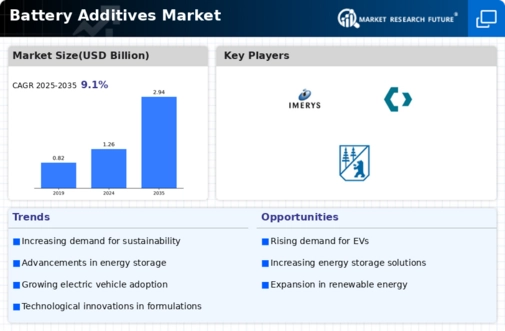Top Industry Leaders in the Battery Additives Market

The global battery additives market is an electrifying one, fuelled by the surging demand for high-performance batteries across diverse applications. This dynamic landscape thrives on fierce competition, with established players battling it out with innovative startups, all vying for a larger slice of the pie. But what's the recipe for success in this complex market? Let's delve into the strategies, factors impacting market share, industry news, and recent developments shaping the competitive landscape.
Strategies that Drive Market Share:
- Innovation is King: Companies like BASF, Albemarle, and Johnson Matthey are pouring resources into research and development, churning out novel additives that enhance battery performance, safety, and lifespan. From electrolyte optimization to silicon anode advancements, continuous innovation is key to staying ahead of the curve.
- Diversification is Crucial: Leading players are expanding their portfolios beyond traditional additives, venturing into adjacent markets like battery recycling and electrode materials. This strategic diversification mitigates risks and capitalizes on new growth opportunities.
- Geographic Expansion: Asia-Pacific, with its booming EV and consumer electronics industries, is a battleground for market share. Companies are strategically setting up manufacturing facilities and partnerships in this region to capitalize on the demand surge.
- Sustainability Takes Center Stage: Environmental consciousness is shaping consumer preferences and regulatory landscapes. Companies are developing eco-friendly additives derived from recycled materials and promoting sustainable manufacturing practices to gain a competitive edge.
- Collaborative Innovation: The industry is witnessing a rise in joint ventures and partnerships between established players and startups. This collaborative approach unlocks expertise, resources, and accelerates the development of next-generation battery technologies.
Factors Influencing Market Share:
- Type of Battery: The market caters to diverse battery chemistries, each with unique additive requirements. Leaders have to excel in specific segments like lithium-ion additives for EVs or lead-acid additives for stationary applications.
- Cost Competitiveness: Price sensitivity is high in this market, particularly for mass-produced batteries. Balancing performance with affordability is a delicate dance that companies must master to gain traction.
- Regulatory Landscape: Stringent regulations on battery safety and environmental impact are shaping the market. Compliance with these regulations is essential for any player to compete effectively.
- Supply Chain Challenges: Securing reliable and sustainable sources of raw materials for additives is crucial. Disruptions in the supply chain can lead to production bottlenecks and affect market share.
- Brand Reputation and Customer Relationships: Building trust and long-term partnerships with battery manufacturers is paramount. A strong brand reputation and reliable customer service can elevate a company's position in the market.
List of Key Players in the Battery Additives Market
- Cabot Corporation (US),
- 3M (US),
- Imerys (France),
- Hammond (US),
- SGL Carbon (Germany),
- Borregaard (Norway),
- HOPAX (Taiwan),
- PENOX (Germany),
- ALTANA (Germany),
- US Research Nanomaterials, Inc (US)
Recent Developments:
August 2023: Albemarle Corporation acquires Chemetall, a German specialty chemicals company, strengthening its portfolio of additives for lithium-ion batteries and fuel cells.
September 2023: Solvay expands its production capacity for lithium bisulfate, a key electrolyte additive, to meet the growing demand from the Asian market.
October 2023: Cabot Corporation partners with a research institute to develop novel conductive additives made from recycled carbon nanotubes, aiming for sustainability and performance improvement.
November 2023: The European Union proposes new regulations on battery production and recycling, mandating the use of certain additives for safety and environmental reasons.
December 2023: A consortium of leading battery manufacturers and researchers announces a multi-million dollar initiative to develop new, high-energy density battery technologies, with a focus on advanced additives.

